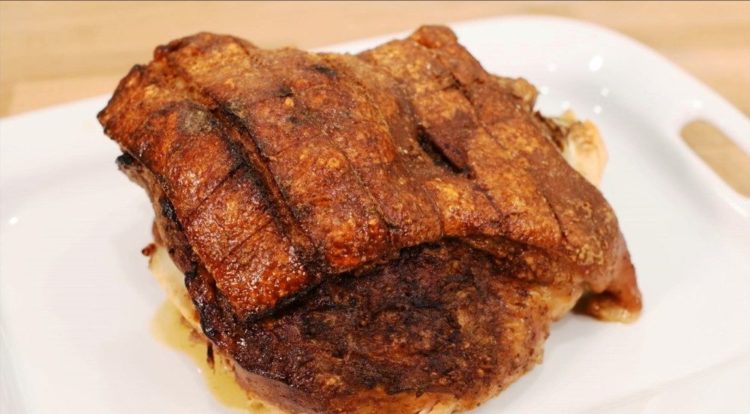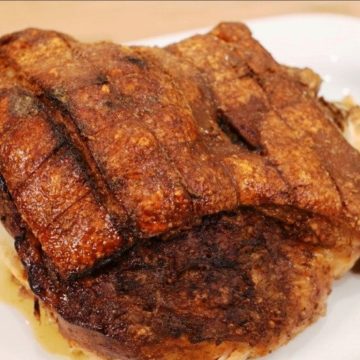Crispy Puerto Rican Pernil
Perhaps the best known and most coveted dish from Puerto Rico, pernil is a positively sumptuous preparation for pork shoulder. It’s marinated (ideally overnight) in garlic, citrus and herbs, then slow-roasted on high heat to achieve a crisp chicharrón, or skin. Traditionally, it’s prepared for Thanksgiving or Christmas, but for those of us in the diaspora, it’s made for most special occasions. Shoulder is also a relatively inexpensive cut of meat, and it yields a lot of servings, leading to exciting leftovers. This recipe is deeply indebted to the chef Maricel Presilla and her recipe in “Gran Cocina Latina,” her cookbook published in 2012. Her method is a foolproof way to get that chicharrón as well as tender meat that falls off the bone. It’s blessed by her brilliance.
Ingredients
ADOBO:
PORK SHOULDER:
- 1 8- to 9-pound bone-in, skin-on pork shoulder, preferably with skin covering the entire top layer
- 1 teaspoon kosher salt
Instructions
- Prepare the adobo by combining all the ingredients and grinding in a large pilón or mortar and pestle, or simply mixing together well in a small bowl.
- Pour over adobo in batches, using your fingers to push adobo deep into the meat. If you’re worried about your hands smelling like garlic — which they will! — wear gloves.
- Set out a long sheet of plastic wrap, layering with subsequent sheets as needed to ensure you can securely wrap the entire pork shoulder. Transfer pork to plastic wrap and wrap tightly, adding sheets of plastic as needed to ensure pork is completely airtight and juices are contained. Let marinate in the fridge overnight if possible, or at least least 2 to 3 hours. Set on a rimmed baking sheet or disposable aluminum foil pan in case it leaks.
- Once the pork has marinated, heat oven to 400 degrees. Working over the sink, carefully remove pork from plastic wrap, discarding any remaining adobo. Place the marinated pork shoulder skin-side up in a deep roasting pan, and wipe the skin with a clean cloth. Rub skin with 1 teaspoon salt.
- Loosely tent foil over the pork shoulder, spraying the foil with cooking spray or brushing with oil in any areas that may touch the skin, as it will stick. Transfer to the center of the oven.
- Roast in the oven for 1 hour, then carefully remove the foil and rotate the pan. Continue roasting for another 2 to 3 hours, rotating every hour or so, and watching closely. Add water to the pan as needed when juices evaporate. The meat is done cooking when the juices run clear and the thickest part of the shoulder registers 160 degrees with a meat thermometer. The skin may take more time to crisp, but watch closely so that it does not burn. Tap the top of the skin with the back of a knife or metal spatula, and listen for a decidedly hollow sound.
- Remove from the oven and let rest for 10 to 15 minutes, then transfer to a large cutting board. (For cleaning instructions for the pan, see Notes.) If desired, remove the skin from the roast by slicing it along the underside of the bone with a long, sharp, slender knife. Run the knife underneath the skin starting from the bottom until loosened, then lift the skin from the meat. Use kitchen shears to cut into serving pieces, and let them rest in the warm oven until ready to eat. Trim excess fat from the meat if desired, and slice as desired, in large chunks or slices, to serve.
- Tips
- You can use a smaller or larger pork shoulder, but calculate your adobo accordingly by using the following formula per pound of meat: 1 large garlic clove, 1 teaspoon olive oil, 1 teaspoon kosher salt, 1/2 teaspoon sour orange juice, 1/2 teaspoon dried oregano and 1/8 teaspoon black pepper. If using a smaller pork shoulder, you may want to reduce the amount of salt slightly.
- Use a pan that can handle char. You can line your pan with foil, but that can be even messier. When you’re ready to clean, combine 1/2 cup baking soda and enough hot water to cover the burned spots, and let rest for half an hour. Char should release easily with your abrasive tool of choice.
Video
Notes
You can use a smaller or larger pork shoulder, but calculate your adobo accordingly by using the following formula per pound of meat: 1 large garlic clove, 1 teaspoon olive oil, 1 teaspoon kosher salt, 1/2 teaspoon sour orange juice, 1/2 teaspoon dried oregano and 1/8 teaspoon black pepper. If using a smaller pork shoulder, you may want to reduce the amount of salt slightly.
Use a pan that can handle char. You can line your pan with foil, but that can be even messier. When you’re ready to clean, combine 1/2 cup baking soda and enough hot water to cover the burned spots, and let rest for half an hour. Char should release easily with your abrasive tool of choice.
Use a pan that can handle char. You can line your pan with foil, but that can be even messier. When you’re ready to clean, combine 1/2 cup baking soda and enough hot water to cover the burned spots, and let rest for half an hour. Char should release easily with your abrasive tool of choice.
Tried this recipe?Let us know how it was!


